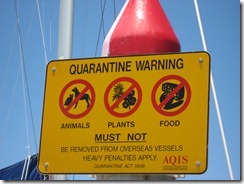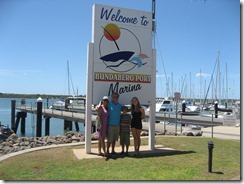 We were ready just over a week ago for Australian Quarantine agents when we entered the Port of Bundaberg early in the morning hours of November 11 – coincidentally exactly 8 months to the day of having departed Mexico for our Pacific crossing. Quarantine was ready for us as well, waiting on the quarantine dock for us as we tied up. We were pleased that the goal seemed to be more about allowing us to keep as much as possible, rather than to confiscate any uncertain items. We had placed all our questionable food items on the cockpit table or in bins on the cockpit benches to make it easier and quicker. Two hours later, we had reviewed all of our food items. While we thought we’d be cleaned out of most of our food, this was not the case. We thought we’d loose so much more than we did.Here is the summary:
We were ready just over a week ago for Australian Quarantine agents when we entered the Port of Bundaberg early in the morning hours of November 11 – coincidentally exactly 8 months to the day of having departed Mexico for our Pacific crossing. Quarantine was ready for us as well, waiting on the quarantine dock for us as we tied up. We were pleased that the goal seemed to be more about allowing us to keep as much as possible, rather than to confiscate any uncertain items. We had placed all our questionable food items on the cockpit table or in bins on the cockpit benches to make it easier and quicker. Two hours later, we had reviewed all of our food items. While we thought we’d be cleaned out of most of our food, this was not the case. We thought we’d loose so much more than we did.Here is the summary:*The obvious: all fresh produce was taken. All canned goods are fine.
*Dried beans and lentils were taken, but not anything split (as in split peas and red lentils were okay). We were allowed to keep our refried beans in vacuum sealed packets still from Mexico.
*Rice and couscous were fine (just examined for any bugs) but barley was taken. Rice noodles and rice paper wrappers were fine. Egg noodles were taken but all other noodles (ramen) were fine. We were allowed to keep our pasta too.
*Oatmeal and cereals were fine.
*Flour was taken but not sugar, and not the Bob Red Mill’s flour still in the original packaging (rye, pizza dough mix, etc.). Frozen bread, tortillas and rotis were all okay to keep.
*We were allowed to keep our herbal teas but sachets were opened to examine them. Quarantine is looking for anything with orange peel in it, which ours had, but because they were pretty pulverized, they were deemed okay. Coffee was fine.
*Corn kernels for popping popcorn was taken, as was the honey we got in Fiji, but not the honey from NZ. Powdered milk and powdered eggs were taken.
*Dried fruit (raisins, cranberries, cherries, goji berries) were all okay to keep, but all nuts were taken.
*All my spices were fine except mustard seeds and whole cinnamon sticks. Anything ground is fine.
*All mayonnaise was taken (2 and half jars!) simply because it did not list the egg content; anything with more than 9% egg content is not okay. Because the egg content again was not listed, two unopened bottles of Harrison’s favorite Ceasar’s salad dressing were taken.
*All other condiments were fine (BBQ sauces, teriyaki sauces, ketchup, mustard, pickles, marinades, vinegars, oils, peanut sauces, jams, peanut butter, apple sauce etc.).
*Cheeses that were made in NZ and Australia were fine. Cream cheese was fine. My homemade yogurt was taken (I love my yogurt maker!).
*Tofu was okay; if I had had any meat left over, I’m pretty sure it would have been taken unless packaged in NZ or Australia. The fish we had in the freezer that we had caught ourselves was all fine.
We were also asked about wooden items like carvings, which were simply examined for termite holes. We had been told to place any woven baskets or wood items into bags and sprayed with insecticide and left for a few days, but when we showed it to the quarantine agent, he said that it wasn’t necessary. He even let Harrision keep his wooden self-built catapult, notwithstanding the termite holes in it; Harrison had made it in NZ so clearly the termites were long gone. The agent simply shook baskets to see if any bugs came out. We were allowed to keep all our sea shells.
All in all it was a pleasant experience.
Customs and Immigration was the standard questions routine. More interesting, however, was the fact that Australia’s second largest drug bust took place the day we arrived on the dock over from ours. Four men (some say British, others Spanish) on a boat called Freedom Friday were caught with about 300 kilos of cocaine with a street value of about $300 million, as well as $20 million in cash on their boat. The drugs had been picked up in Vanuatu three weeks earlier, and the guys thought they could slip in under the radar screen by signing up for the Port to Port (Port Vila, Vanuatu to Port Bundaberg, Australia) Rally which we were also a part of. The customs people spent two full days pulling apart the boat down to its bones. The boat became known as Jailed Saturday.
 Our experiences here have thankfully not been as dramatic, although what has stood out for us over the week plus that we’ve been here is the number of signs setting out instructions and rules that we’ve seen. It’s been a long time since we’ve been anywhere with so many rules. In fact, there are so many rules, that they get lost as background noise. And yet, ironically, with so many rules, Aussies are some of the most laid back people around.
Our experiences here have thankfully not been as dramatic, although what has stood out for us over the week plus that we’ve been here is the number of signs setting out instructions and rules that we’ve seen. It’s been a long time since we’ve been anywhere with so many rules. In fact, there are so many rules, that they get lost as background noise. And yet, ironically, with so many rules, Aussies are some of the most laid back people around. -Barb
Down Under, with a sparkling clean and much lighter boat – after spending the first week scrubbing and de-cluttering; we haven’t been on a dock in 8 months!
